|
National Archaeological Museum of Athens - Prehistoric Collection
The New York Times has recently (April 2008) published an article on Athens. In it there is a reference to the National Archaeological Museum of Athens: "In neighboring Exarcheia, the renovated National Archaeological Museum (Patission 44; 30-210-821-7724) has classical sculptures and gold treasures from Mycenae". We think of this reference as being the Understatement of the century! |
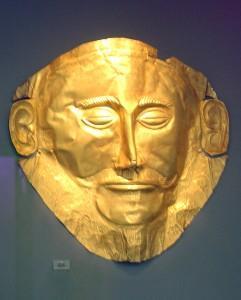 |
Athens National Archaeological Museum:
Exhibit 624. Gold death-mask, known as
the 'mask of Agamemnon'. (Grave V,
Grave Circle A, Mycenae, 16th century BC) |
This is because the Greek National Archaeological Museum in Athens is rightfully considered to be not only the most important, yet also one of the richest archaeological museums in the world in terms of containing Ancient Greek Art! Please refer to the relevant Album as proof of how much right we are!
The Greek National Archaeological Museum is housed in a neoclassical building designed by the noted German architect Ernst Ziller in 1889. It houses perhaps the most impressive collection of ancient Greek treasures in the world. The neoclassical design of the exterior tries its best to keep up with the true Greek classic style of the works it houses. This museum includes the golden so-called "Mask of Agamemnon", excavated by Heinrich Schliemann at ancient Mycenae, the bronze "boy jockey" of Artemision that somehow stayed in great condition despite being fished out of the sea, and a range of excellent sculptures, pottery, furniture and jewellery.
Further wonderful inclusions are:
- Prehistoric items/Ruins
- Sculpture
- Pottery and Minor art
- Bronzes
- Egyptian Art
Operating Hours are as follows:
Monday 13.00-19.30
Tuesday-Sunday 08.30-15.00
Telephone Contact: 210/821-7717 Address: 44, 28th Oktovriou (Patission) Ave, Athens, Greece |
Note: Given the huge number of exhibits, this album on the National Archaeological Museum of Athens is progressing step by step: Please visit this Album from time to time to see it growing!
(Photos: Michael Tziotis)
Select Page of the Album:
- The National Archaeological Museum of Athens: Why this Album?
- The National Archaeological Museum of Athens (The Building)
- Prehistoric Collection / Gallery IV / Mycenaean Civilization / Mycenae
- Gallery IV / Mycenaean Civilization / Mycenae / Grave Circle A / Finds from Graves I, II and VI, 16th century BC
- Gallery IV / Mycenaean Civilization / Mycenae / Grave Circle A / Finds from Grave III, 16th century BC (Window 1)
- Gallery IV / Mycenaean Civilization / Mycenae / Grave Circle A / Finds from Grave III, 16th century BC (Window 2)
- Gallery IV / Mycenaean Civilization / Mycenae / Grave Circle A / Finds from Grave IV, 16th century BC.
- Gallery IV / Mycenaean Civilization / Mycenae / Grave Circle A / Finds from Grave V, 16th century BC.
- Gallery IV / Mycenaean Civilization / Mycenae / Grave Circle A / Jewelry from Graves IV and V, 16th century BC.
- Gallery IV / Mycenaean Civilization / Mycenae / Grave Circle A / Gold and silver tableware from Graves IV and V, 16th century BC.
- Gallery IV / Mycenaean Civilization / Mycenae / Grave Circle A / Pottery vessels, 16th- early 15th century BC.
- Gallery IV / Mycenaean Civilization / Mycenae / Grave Circle A / Ritual vases-rhytons from Graves IV and V, 16th century BC.
- Gallery IV / Mycenaean Civilization / Mycenae / Grave Circle A / Exotic Objects, 16th century BC.
- Gallery IV / Mycenaean Civilization / Mycenae / Grave Circle A / Bronze vessels and tools from Graves III, IV and V, 16th century BC.
- Gallery IV / Mycenaean Civilization / Mycenae / Grave Circle A / Weapons and implements from Grave IV, 16th century BC.
- Gallery IV / Mycenaean Civilization / Mycenae / Grave Circle A / Weapons and implements from Grave V, 16th century BC.
- Gallery IV / Mycenaean Civilization / Mycenae / Grave Circle B / Finds from Graves Alpha, Zeta, Eta and Kappa, 17th-16th cent. BC
- Gallery IV / Mycenaean Civilization / Mycenae / Grave Circle B / Finds from the Male Inhumations in Grave Nu & the Female One in Grave Omicron, 17th-16th cent. BC
- Gallery IV / Mycenaean Civilization / Mycenae / Grave Circle B / Finds from Grave Gamma and Delta, 17th-16th cent. BC
- Gallery IV / Mycenaean Civilization / Mycenae / Grave Circle B / Finds from Graves Beta, Epsilon, Iota, Lamda, Mu, Xi, Upsilon, 16th century BC.
- Gallery IV / Mycenaean Civilization / Mycenae / Bone, Glass and Ivory Artifacts from the Mycenean Acropolis
- Gallery IV / Mycenaean Civilization / Mycenae / Palatial Workshops Finds and Bronze Weapon and Tool Hoards in the Acropolis of Mycenae, 14th-13th centuries BC
- Gallery IV / Mycenaean Civilization / Mycenae / Imported objects and raw materials from abroad, most found on the Mycenae acropolis.
- Gallery IV / Mycenaean Civilization / Mycenae / Clay and stone ritual vessels, used in religious ceremonies (15th-12th century BC).
- Gallery IV / Mycenaean Civilization / Mycenae / Pictorial Style pottery from the Mycenae acropolis.
- Gallery IV / Mycenaean Civilization / Mycenae / Wall-Paintings
- Gallery IV / Mycenaean Civilization / Tiryns/The Tiryns wall-paintings
- Gallery IV / Mycenaean Civilization / Tiryns/The Acropolis of Tiryns
Click on any of the pictures to enlarge.
Gallery IV / Mycenaean Civilization / Mycenae / Palatial Workshops Finds and Bronze Weapon and Tool Hoards in the Acropolis of Mycenae, 14th-13th centuries BCPalatial workshops
Several groups of ivory artifacts were found in the ivory workshops outside of the acropolis at Mycenae, and individual items were dispersed both inside and outside of the citadel (14th-13th centuries BC). Elephant and hippopotamus tusks were used as raw materials.
Ivory plaques, which once decorated luxury furniture, come in various shapes and bear motifs such as heraldic opposing sphinxes (imaginary creatures with a woman's head and a lion's body) , sea shells, columns, nautilus shells, lions, spirals and ivy leaves.These plaques were burnt during the fire which destroyed the 'House of the Sphinxes' at the end of the 13th century.
More ivory plaques, which once decorated luxury furniture, were found. They are in the shape of figure-of-eight shields, warriors with boar's tusk helmets, a helmet, dolphins, sea shells and nautilus shells, ivy leaves and papyrus flowers. One plaque depicts a lion chasing a goat, while another is decorated with a band of half rosettes. These plaques were burnt during the fire, which destroyed the 'House of the Shields' at the end of the 13th century BC.
Bronze weapons and tools hoarded in the Mycenae acropolis
Bronze weapons and tools were hoarded in the Mycenae acropolis before its destruction at the end of the 13th century BC. These hoards comprise sets of heterogeneous objects probably collected by bronze-smiths for re-use as raw materials. They include a large number of swords, one of them with spiral decoration on the blade, a horse's bridle, wheels from chariot models, axes, chisels, sickle-shaped knives, razors, tweezers and arrow heads. A smaller hoard, including a hammer, was uncovered outside of the citadel.
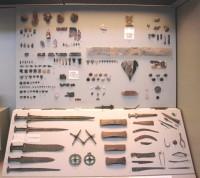
National Archaeological Museum: Gallery IV / Palatial Workshops Finds and Bronze Weapon and Tool Hoards in the Acropolis of Mycenae. 14th-13th centuries BC. (General Photo of Window) |
|
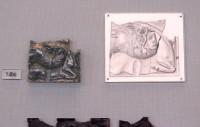
7400. Plaque depicting a lion chasing a goat. 'House of the Shields', end of 13th century BC. |
|
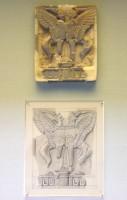
7525. Ivory plaque depicting heraldic opposing sphinxes (imaginary creatures with a woman's head and a lion's body). 'House of the Sphinxes', end 13th century BC. |
|
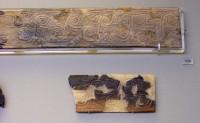
7550. Ivory band decorated with spirals. 'House of the Sphinxes', end of 13th cent. BC. |
|
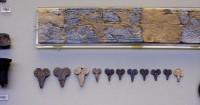
7550. One more part of the ivory band decorated with spirals. 'House of the Sphinxes', end of 13th cent. BC. |
|
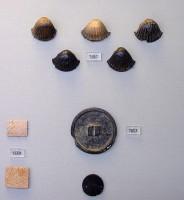
7587. Ivory plaques in the form of sea shells. 'House of the Sphinxes', end of 13th cent. BC. |
|
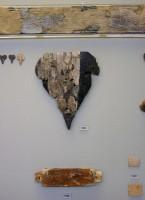
7601. Ivory plaques in the form of ivy leaves . 'House of the Sphinxes', end of 13th cent. BC. |
|
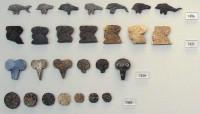
7416, 7421, 7419, 7469. Ivory plaques in the shape of dolphins (7416) and nautilus shells (7421), papyrus flowers (7419) and rosettes (7469). 'House of the Shields', end of 13th century BC. |
|
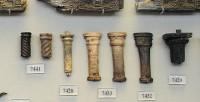
7441, 7428, 7433, 7432, 7429. Ivory plaques in various shapes. |
|
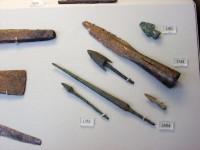
1351, 2554, 2741. Arrows and spear-heads (from the Mycenae acropolis bronze hoards) |
|
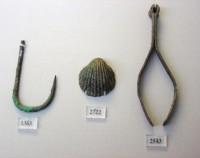
1363, 2722, 2543. Hook, seashells and tweezers (from the Mycenae acropolis bronze hoards) |
|
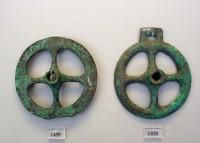
1409, 1410. Wheels from chariot models (from the Mycenae acropolis bronze hoards). |
|
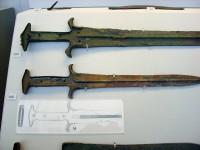
2536, 2537. Swords, one of them with spiral decoration on the blade (from the Mycenae acropolis bronze hoards). |
|
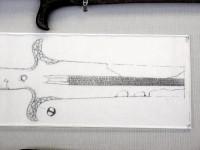
2536. The drawing of the spiral decoration on the blade of sword exh. 2536 |
|
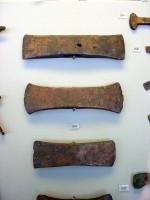
2541. Axes (from the Mycenae acropolis bronze hoards). |
|
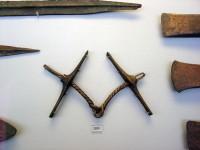
2553. A horse's bridle (from the Mycenae acropolis bronze hoards). |
|
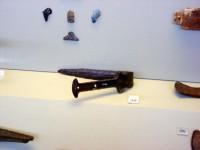
2649. A sword, bent to 'kill the blade', so that it remains eternally in the possession of its dead owner (from the Mycenae acropolis bronze hoards). |
|
|
Select Page of the Album:
- The National Archaeological Museum of Athens: Why this Album?
- The National Archaeological Museum of Athens (The Building)
- Prehistoric Collection / Gallery IV / Mycenaean Civilization / Mycenae
- Gallery IV / Mycenaean Civilization / Mycenae / Grave Circle A / Finds from Graves I, II and VI, 16th century BC
- Gallery IV / Mycenaean Civilization / Mycenae / Grave Circle A / Finds from Grave III, 16th century BC (Window 1)
- Gallery IV / Mycenaean Civilization / Mycenae / Grave Circle A / Finds from Grave III, 16th century BC (Window 2)
- Gallery IV / Mycenaean Civilization / Mycenae / Grave Circle A / Finds from Grave IV, 16th century BC.
- Gallery IV / Mycenaean Civilization / Mycenae / Grave Circle A / Finds from Grave V, 16th century BC.
- Gallery IV / Mycenaean Civilization / Mycenae / Grave Circle A / Jewelry from Graves IV and V, 16th century BC.
- Gallery IV / Mycenaean Civilization / Mycenae / Grave Circle A / Gold and silver tableware from Graves IV and V, 16th century BC.
- Gallery IV / Mycenaean Civilization / Mycenae / Grave Circle A / Pottery vessels, 16th- early 15th century BC.
- Gallery IV / Mycenaean Civilization / Mycenae / Grave Circle A / Ritual vases-rhytons from Graves IV and V, 16th century BC.
- Gallery IV / Mycenaean Civilization / Mycenae / Grave Circle A / Exotic Objects, 16th century BC.
- Gallery IV / Mycenaean Civilization / Mycenae / Grave Circle A / Bronze vessels and tools from Graves III, IV and V, 16th century BC.
- Gallery IV / Mycenaean Civilization / Mycenae / Grave Circle A / Weapons and implements from Grave IV, 16th century BC.
- Gallery IV / Mycenaean Civilization / Mycenae / Grave Circle A / Weapons and implements from Grave V, 16th century BC.
- Gallery IV / Mycenaean Civilization / Mycenae / Grave Circle B / Finds from Graves Alpha, Zeta, Eta and Kappa, 17th-16th cent. BC
- Gallery IV / Mycenaean Civilization / Mycenae / Grave Circle B / Finds from the Male Inhumations in Grave Nu & the Female One in Grave Omicron, 17th-16th cent. BC
- Gallery IV / Mycenaean Civilization / Mycenae / Grave Circle B / Finds from Grave Gamma and Delta, 17th-16th cent. BC
- Gallery IV / Mycenaean Civilization / Mycenae / Grave Circle B / Finds from Graves Beta, Epsilon, Iota, Lamda, Mu, Xi, Upsilon, 16th century BC.
- Gallery IV / Mycenaean Civilization / Mycenae / Bone, Glass and Ivory Artifacts from the Mycenean Acropolis
- Gallery IV / Mycenaean Civilization / Mycenae / Palatial Workshops Finds and Bronze Weapon and Tool Hoards in the Acropolis of Mycenae, 14th-13th centuries BC
- Gallery IV / Mycenaean Civilization / Mycenae / Imported objects and raw materials from abroad, most found on the Mycenae acropolis.
- Gallery IV / Mycenaean Civilization / Mycenae / Clay and stone ritual vessels, used in religious ceremonies (15th-12th century BC).
- Gallery IV / Mycenaean Civilization / Mycenae / Pictorial Style pottery from the Mycenae acropolis.
- Gallery IV / Mycenaean Civilization / Mycenae / Wall-Paintings
- Gallery IV / Mycenaean Civilization / Tiryns/The Tiryns wall-paintings
- Gallery IV / Mycenaean Civilization / Tiryns/The Acropolis of Tiryns
|
|
|
|



